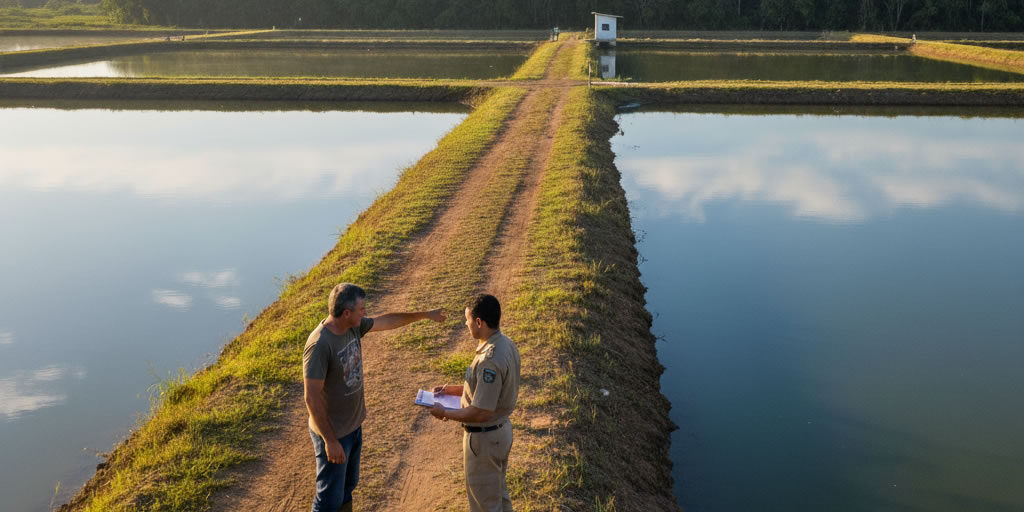- Software Gestor para Aquicultura
- (85) 2139-6730
- contato@despesca.com.br
On-Farm Inspections: Be Prepared. What Are the Main Items Checked by Environmental and Health Agencies?

Leaving the Farm Gate: How to Create Your Own Brand and Sell Shrimp Directly to the Consumer
02/09/2025
Genetic Improvement in Aquaculture: The Foundation for High Productivity and Health on Your Farm
04/09/2025A visit from an inspection agency shouldn’t be a cause for panic, but rather a confirmation that good production and management practices are being applied. For shrimp or fish farmers, being in compliance with environmental and health legislation is a fundamental pillar, not only to avoid fines and sanctions but also to ensure the business’s sustainability, access to more demanding markets, and credit lines.
An inspection, whether environmental or sanitary, is a standard procedure aimed at ensuring that the production activity is in balance with the environment and that the final product is safe for the consumer. The organization and detailed recording of all farm operations are the producer’s greatest allies at this moment.
Environmental Inspection: Focusing on Production Sustainability
The main concern of environmental agencies is the impact of aquaculture on ecosystems. The inspector will verify if the farm operates in a way that minimizes these impacts, based on licenses and authorizations that regulate the enterprise. The main points of attention are:
- Environmental Licensing: This is the most important document. The producer must have and present the Operating License (OL), which authorizes the activity’s operation. Inspectors may also request previous licenses, the Preliminary License (PL) and the Installation License (IL), to verify that all project stages have followed the established conditions.
- Water Use Grant: All water abstraction (from rivers, wells, lakes) and the discharge of effluents into water bodies must be authorized by the water resources management body. The grant defines the permitted volumes for abstraction and the quality standards for water disposal, being a mandatory verification item.
- Effluent and Waste Management: The farm’s method of treating water before returning it to the environment will be checked. The existence and efficiency of sedimentation basins, filters, or other treatment systems are crucial. Likewise, the correct disposal of solid waste, such as feed bags, inputs, and dead animals, will be inspected to prevent soil and water contamination.
- Permanent Preservation Areas (PPA) and Legal Reserve (LR): The inspector will check if the farm’s boundaries respect the PPAs (such as riparian forests around rivers and springs) and if the Legal Reserve is duly registered and conserved, as required by the Forest Code.
Health Inspection: Ensuring a Safe and Quality Product
The focus of health surveillance is food safety, from cultivation to harvesting and processing. The goal is to ensure that the fish reaching the consumer is free from contamination and was produced under proper hygiene conditions.
- Traceability: This is an increasingly required item. The producer needs to prove the origin of their inputs. This includes invoices for post-larvae or fingerlings (proving they come from reputable laboratories), feed lots, and any medications or probiotics used. Recording which feed lot was used in each pond and during which period is essential.
- Good Management Practices (GMP): Inspectors evaluate the farm’s operational procedures. This involves checking feed storage (dry, ventilated place, on pallets), pond water quality control (records of parameter monitoring), and feeding and biometry practices, which indicate careful management.
- Disease Control: A sanitary management plan must be presented. The use of medications must be prescribed by a qualified professional, and records of application (dose, period, pond) must be available. The notification of mandatory reportable diseases to health defense agencies is also verified.
- Hygiene of Facilities and Equipment: The general cleanliness of the farm, handling equipment (nets, buckets), support facilities, and especially the area where harvesting and processing (if any) are carried out, is rigorously inspected.
How Management Technology Prepares the Farm for Inspections
Keeping all these documents, records, and proofs organized manually is a complex task prone to errors. This is where a management software like Despesca becomes an indispensable strategic tool.
With a management system, the producer centralizes all critical information in one place. It is possible to record the entry of inputs with invoices and lots, control the stock of feed and medications, and daily record all management activities, from measuring water parameters to applying products. During an inspection, instead of searching for scattered papers and spreadsheets, the producer can generate complete traceability reports and management histories for each pond with just a few clicks, demonstrating organization, control, and professionalism. Furthermore, the system can issue alerts about the validity of licenses and grants, preventing the farm from operating irregularly due to oversight.
In summary, being prepared for an inspection is not about fearing a visit from an inspector, but about adopting a culture of organized and proactive management. Regularization and detailed recording of operations protect the producer, add value to their product, and ensure the longevity of their activity in the growing aquaculture market.

